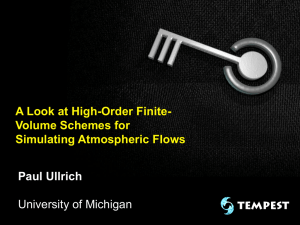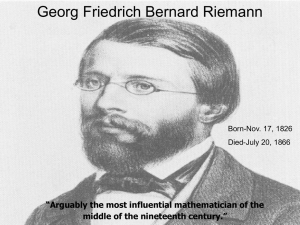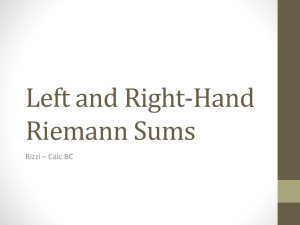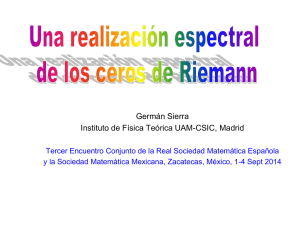Gas-kinetic Scheme
advertisement
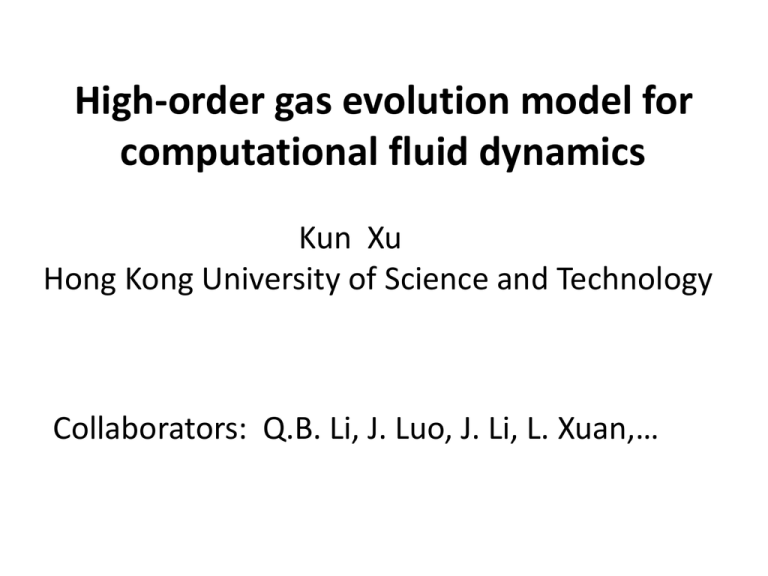
High-order gas evolution model for computational fluid dynamics Kun Xu Hong Kong University of Science and Technology Collaborators: Q.B. Li, J. Luo, J. Li, L. Xuan,… Fluid flow is commonly studied in one of three ways: – Experimental fluid dynamics. – Theoretical fluid dynamics. – Computational fluid dynamics (CFD). Experiment Theory Scientific Computing Contents • • • • • The modeling in gas-kinetic scheme (GKS) The Foundation of Modern CFD High-order schemes Remarks on high-order CFD methods Conclusion Computation: a description of flow motion in a discretized space and time Collision The way of gas molecules passing through the cell interface depends on the cell resolution and particle mean free path Gas properties Continuum Air at atmospheric condition: 2.5x1019 molecules/cm3, Mean free path : 5x10-8m, Collision frequency : 109 /s Gradient transport mechanism Navier-Stokes-Fourier equations (NSF) Martin H.C. Knudsen (1871-1949) Danish physicist Rarefaction Typical length scale: L Knudsen number: Kn=/L High altitude, Vacuum ( ) , MEMS (L ) Kn 5 Physical modeling of gas flow in a limited resolution space f : gas distribution function, W : conservative macroscopic variables Fundamental governing equation in discretized space: n 1 j f f n j 1 x t n 1 t n 1 [ufx j 1 / 2(t ) uf x j 1 / 2(t )]dt x t n 1 t n xj 1 / 2 x Q(f ,f )dxdt j 1 / 2 Take conservative moments to the above equation: W n 1 j 1 t n1 W u ( f j 1/ 2 f j 1/ 2 )du ddt n t x n j For the update of conservative flow variables, we only need to know the fluxes across a cell interface! PDE-based modeling:use PDE’s local solution to model the physical process of gas molecules passing through the cell interface 6 The physical modeling of particles distribution function at a cell interface f(x j 1 / 2 ,t ,u ,v , ) where 1 t (t t ') / t / g ( x ' , t ' , u , v , ) e dt ' e f0(x j 1 / 2 ut ) 0 x ' x j 1 / 2 u(t t ') is the particle trajectory. t n 1 x j 1/ 2 x'u(t t ' ) g f0 tn x j 1/ 2 7 Modeling for continuum flow: f0 : constructed according to Chapman-Enskog expansion gl g0 gr g xj x j 1 / 2 x j 1 8 Smooth transition from particle free transport to hydrodynamic evolution f(x j 1 / 2 ,t ,u ,v , ) 1 t (t t ') / t / g ( x ' , t ' , u , v , ) e dt ' e f0(x j 1 / 2 ut ) 0 f ( x j 1/ 2 , t , u, v, ) (1 e t / ) g 0 (t / 1 e t / ) Ag 0 ( (1 e t / ) te t / l t r )(a H(u ) a (1 H(u ))ug0 Hydrodynamics scale e t / ((a l u (t ) Al )H(u ) g l (a r u (t ) Ar )(1 H(u ))g r ) e t / (H(u ) g l (1 H(u ))g r ), Discontinuous (kinetic scale, free transport) t : • Numerical fluxes F FU F V F E j 1 / 2 u 1 (u 2 2 1 u f ( x j 1 / 2 , t , u, v, )d. v 2 2 v ) • Update of flow variables: w n 1 j w n j t 1 x 0 ( F j 1 / 2 (t ) F j 1 / 2 (t ))dt. • Prandtl number fix by modifying the heat flux in the above equation 10 Gas-kinetic Scheme ( t / , x / ) Upwind Scheme Kinetic scale Central-difference Hydrodynamic scale 11 M. Ilgaz, I.H. Tuncer, 2009 12 13 14 15 2 Present (upside) Present (lower side) Exp (upside) Exp (lower side) Cp 1.5 1 0.5 0 0 0.2 0.4 0.6 0.8 1 x/L High Mach number flow passing through a double ellipse Y Section 3 z/b=0.65 1.2 X Z 0.8 Cp 1 0.8 0.6 0.4 0.2 0 -0.2 -0.4 -0.6 -0.8 -1 -1.2 -1.4 -Cp 0.4 0 S-A SST Menter Transition Exp Exp -0.4 -0.8 0 0.2 0.4 0.6 x/L M6 airfoil 0.8 1 M=10, Re=10^6, Tin=79K, Tw=294.44K, mesh 15x81x19 Hollow cylinder flare: nitrogen Mesh 61x105x17 temperature pressure The Foundation of Modern CFD 21 Modern CFD (Godunov-type methods) Governing equations: Euler, NS, … Introduce flow physics into numerical schemes (FDS, FVS, AUSM, ~RPs) Spatial Limiters (Boris, Book, van Leer,…70-80s) (space limiter) 22 A black cloud hanging over CFD clear sky (1990- now) Carbuncle Phenomena Roe AUSM+ 23 M=10 GKS GRP 24 Godunov’s description of numerical shock wave Is this physical modeling valid ? 25 Physical process from a discontinuity Gas kinetic scheme Particle free transport Godunov method collision ? NS NS Riemann solver Euler Euler (infinite number of collisions) 26 High-order schemes (order =>3) Reconstruction + Evolution The foundation of most high-order schemes: 1st-order dynamic model: Riemann solver inviscid viscous High-order Kinetic Scheme (HBGK-NS) BGK-NS (2001) HBGK (2009) 29 High-order gas-kinetic scheme (HGKS) Comparison of gas evolution model: Godunov vs. Gas-Kinetic Scheme (a): gas-kinetic evolution (b): Riemann solver evolution Space & time, inviscid & viscous, direction & direction, kinetic & Hydrodynamic, fully coupled ! High-order Gas-kinetic scheme: one step integration along the cell interface. Gauss-points: Riemann solvers for others Re 105 Laminar Boundary Layer 1 1 + + + + 0.8 0.8 + 0.6 U* + + + x/L= 0.0247 x/L= 0.2625 x/L= 0.6239 Blasius 0.4 + + 0.2 + V* + 0.4 0.2 + + 0 + x/L= 0.0247 x/L= 0.2625 x/L= 0.6239 Blasius + + 0 + + + 0.6 + + + 0 ++ 2 4 y* 6 8 0 + 2 4 y* 6 8 32 Viscous shock tube 500x250 mesh points 5th-WENO 6th-order viscous Reference solution 4000x2000 mesh points Sjogreen& Yee’s 6th-order WAV66 scheme 500x250 mesh points 5th-WENO-reconstruction +Gas-Kinetic Evolution 1000x500 Sjogreen& Yee’s 6th-order WAV66 scheme 1000x500 Gas Kinetic Scheme 1400x700 Gas-kinetic Scheme Osmp7 (4000x2000) Remarks on high-order CFD methods Mathematical manipulation (weak solution) ? physical reality i 1/2 U U f ˆ V t x dx V t dx ( f Riem ) i1/2 V f x dx 0 i i i There is no any physical evolution law about the time evolution of derivatives in a discontinuous region ! Even in the smooth region, in the update of “slope or high-order derivatives” through weak solution, the Riemann solver (1st-order dynamics) does NOT provide appropriate dynamics. Example: Riemann solver only provides u, not at a cell interface Huynh, AIAA paper 2007-4079 Unified many high-order schemes DG, SD, SV, LCP, …, under flux reconstruction framework Fi ( x ) Fi ( x ) Riemann Flux Fi ( x ) Interior Flux dui , j dt dFi ( xi , j ) dx 0 Fi ( x ) Z.J. Wang STRONG Solution from Three Piecewise Initial Data Update flow variables at nodal points ( , ) at next time level, And calculate flux Solution at t=∆𝑡 Reconstructed new initial condition from nodal values Initial condition at t=0 𝑥𝑗−1/2 𝑥𝑗+1/2 Generalized solutions with piecewise discontinuous initial data W(x)= 𝑊1 𝑥 , 𝑥 < 𝑥𝑗−1/2, 𝑊2 𝑥 , 𝑥𝑗−1/2 < 𝑥 < 𝑥𝑗+1/2 , 𝑊3 𝑥 , 𝑥 > 𝑥𝑗+1/2 𝑡=0 PDE’s local evolution solution (strong solution) is used to Model the gas flow passing through the cell interface in a discretized space. Control Volume x, t PDE-based Modeling Different scale physical modeling quantum Boltzmann Eqs. Newton Navier-Stokes Euler Flow description depends on the scale of the discretized space 44 Conclusion • GKS is basically a gas evolution modeling in a discretized space. This modeling covers the physics from the kinetic scale to the hydrodynamic scale. • In GKS, the effects of inviscid & viscous, space & time, different by directions, and kinetic & hydrodynamic scales, are fully coupled. • Due to the limited cell size, the kinetic scale physical effect is needed to represent numerical shock structure, especially in the high Mach number case. Inside the numerical shock layer, there is no enough particle collisions to generate the so-called “Riemann solution” with distinctive waves. The Riemann solution as a foundation of modern CFD is questionable. • In the discontinuous case, there is no such a physical law related to the time evolution of highorder derivatives. The foundation of the DG method is not solid. It may become “a game of limiters” to modify the updated high-order derivatives in high speed flow computation.
